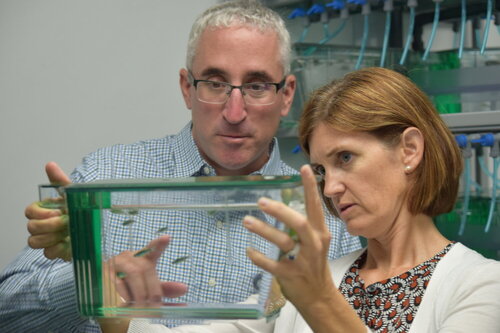The Greenwood Genetic Center’s (GGC) Rich Steet, PhD, Director of Research, and Heather Flanagan-Steet, PhD, Director of Functional Studies, have secured a renewal of their long-standing grant titled ‘Pathogenic Mechanisms of Lysosomal Disease.’
The R01 grant, which is administered by the National Institute of Neurological Disorders and Stroke (NINDS), a division of the National Institutes of Health (NIH), provides $1.2 million over four years to continue the team’s ongoing work to better understand the mechanisms behind lysosomal storage disorders (LSDs).

The duo has spent years studying the function of lysosomes and how their abnormal function results in the clinical features associated with LSDs. While the clinical features vary between different types of LSDs, common findings include coarse facial features, cardiac and skeletal anomalies, learning difficulties, and a shortened life span.
Prior research under this grant focused on a single disorder, mucolipidosis type II (MLII). The research team has made significant progress in understanding how MLII symptoms develop, and they have been able to successfully treat cardiac and skeletal disease manifestations in their zebrafish models. This breakthrough has fostered collaborations to advance treatment studies into a mammalian model with the ultimate goal of developing an effective therapy for patients with this rare disease.
“We are pleased that our prior work on LSDs has been so fruitful and that we are able to continue to move toward better understanding and novel treatment options for families impacted by these rare disorders,” said Steet.
The primary hypothesis for this new round of funding is that the mechanisms identified in MLII are similar across other LSDs, which could lead to novel therapies for several disorders.
The grant renewal will also allow the research team to expand their work on the NUS1 gene which came to the team’s attention through functional studies on a GGC patient.
Through both cellular and zebrafish experiments, researchers were able to confirm that this patient’s NUS1 variant was pathogenic, and they were also able to identify the likely mechanism and a possible therapy.
“Zebrafish that mimic this NUS1 variant not only exhibited a movement disorder as seen through abnormal swimming patterns, but they also displayed significant accumulation of cholesterol in their lysosomes,” said Flanagan-Steet. “By using an FDA-approved small molecule, we were able to reduce cholesterol storage in the zebrafish and restore normal swimming behaviors.”
The additional funding through the grant renewal will also help the research team to refine how the storage of cholesterol in the lysosomes occurs in patients with NUS1 mutations and why it leads to neurological symptoms and movement disorders.
“After completing 13 years of research through this grant funding, we are excited by the potential to further unravel the mysteries of lysosomal storage disorders and identify novel treatments that can help GGC patients and the thousands of others who are impacted by LSDs,” said Steet. “While this renewal continues to support our ongoing basic research, it also allows us to expand our work into patient-specific projects here at GGC.”
